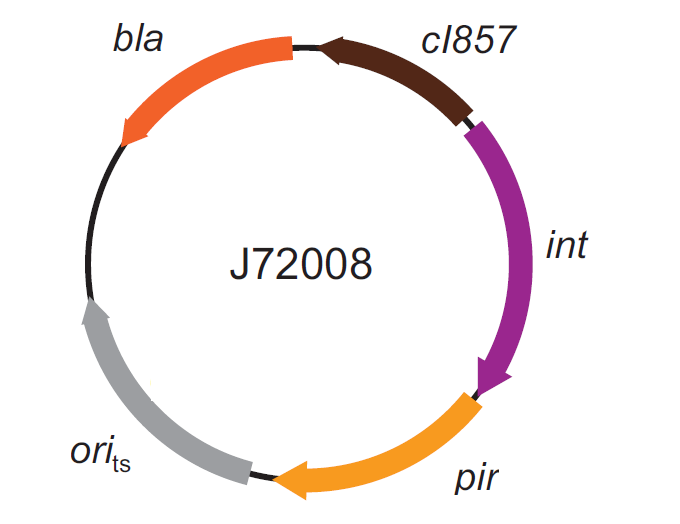Team:UNIPV-Pavia/Project/solution
From 2010.igem.org
(→How to perform multiple integrations in the same genome) |
(→How to perform genome integration) |
||
| Line 193: | Line 193: | ||
{|align=center | {|align=center | ||
|valign=top|[[Image:k300000helper.jpg|thumb|330px|center|Figure 5: Schematic description of the <partinfo>BBa_J72008</partinfo> plasmid. ''cI857'' is the expression system for the thermoinducible cI repressor; ''int'' is the Phi80 integrase regulated by the lambda cI-repressible promoter; ''pir'' is the expression system for the pir-116 gene which is able to trigger the propagation of the R6K conditional replication origin; ''ori_ts'' is the heat-sensitive replication origin (low copy) of the vector; ''bla'' is the Ampicillin resistance marker.]] | |valign=top|[[Image:k300000helper.jpg|thumb|330px|center|Figure 5: Schematic description of the <partinfo>BBa_J72008</partinfo> plasmid. ''cI857'' is the expression system for the thermoinducible cI repressor; ''int'' is the Phi80 integrase regulated by the lambda cI-repressible promoter; ''pir'' is the expression system for the pir-116 gene which is able to trigger the propagation of the R6K conditional replication origin; ''ori_ts'' is the heat-sensitive replication origin (low copy) of the vector; ''bla'' is the Ampicillin resistance marker.]] | ||
| - | |valign=top|[[Image:k300000recombsite.jpg|thumb|500px|center|Figure 6: Schematic description of site-specific recombination between a bacteriophage attP attachment site in the plasmid and an attB attachment site in the bacterial genome. This process is mediated by a specific integrase.]] | + | |valign=top|[[Image:k300000recombsite.jpg|thumb|500px|center|Figure 6: Schematic description of site-specific recombination between a bacteriophage attP attachment site in the plasmid and an attB attachment site in the bacterial genome. In this way the sequence of interest (called "Part" in the figure) can be stably integrated into the attB genomic locus. This process is mediated by a specific integrase.]] |
|} | |} | ||
Revision as of 11:02, 23 October 2010
|
This vector can be considered as a base vector, which can be specialized to target the desired integration site in the host genome. The default version of this backbone has the bacteriophage Phi80 attP (<partinfo>BBa_K300991</partinfo>) as integration site. This vector enables multiple integrations in different positions of the same genome.
GlossaryThe passenger is the desired DNA part to be integrated into the genome. The guide is the DNA sequence that is used to target the passenger into a specific locus in the genome.
The main design features for vector engineering and for the genome integration of the vector are reported below. Vector engineering features:
Genome integration features:
How to use it<partinfo>BBa_K300000</partinfo> can be:
How to propagate it before performing genome integrationThe default version of this vector contains the <partinfo>BBa_I52002</partinfo> insert, so it *must* be propagated in a ccdB-tolerant strain such as DB3.1 (<partinfo>BBa_V1005</partinfo>). After the insertion of the desired BioBrick part in the cloning site, this vector does not contain a standard replication origin anymore, so it *must* be propagated in a pir+ or pir-116 strain such as BW25141 (<partinfo>BBa_K300984</partinfo>) or BW23474 (<partinfo>BBa_K300985</partinfo>) that can replicate the R6K conditional origin (<partinfo>BBa_J61001</partinfo>).
How to engineer itThe DNA guide can be changed as follows:
How to perform genome integrationThe integration into the E. coli chromosome can exploit the bacteriophage attP-mediated integration or the homologous recombination. Detailed protocols about attP-mediated integration can be found here:
Detailed protocols about homologous recombination can be found here:
This integration method is applicable when the host strain does not have prophages in the att(Phi80) locus. TOP10 (<partinfo>BBa_V1009</partinfo>) and DH5alpha (<partinfo>BBa_V1001</partinfo>) strains have the Phi80 prophage and so their chromosome cannot be engineered with this procedure. The genomic integration of the desired BioBrick part into the attP(Phi80) locus has to be mediated by co-transforming a helper plasmid, such as the Amp-resistant <partinfo>BBa_J72008</partinfo> plasmid) which carries the IntPhi80 site-specific integrase gene under the control of a thermoinducible promoter (see Fig.5). The helper plasmid also has a heat-sensitive replication origin, whose replication can be inhibited at temperatures of 37-42°C, while a permissive temperature for this vector is 30°C. For this reason, it can be cured at high temperatures, when the integrase expression is triggered at the same time. The Phi80 integrase mediates the site-specific recombination between the attP site in the integrative vector and the attB site in the bacterial genome (for a schematic description of this process, see Fig.6 and http://partsregistry.org/Recombination). Thanks to its R6K conditional replication origin, the integrative vector cannot be replicated in common E. coli strains, so the Chloramphenicol resistant bacteria are actual integrants. In the Materials and Methods section (https://2010.igem.org/Team:UNIPV-Pavia/Project/results), a detailed protocol to target the desired BioBrick part into the Phi80 locus is reported. How to perform multiple integrations in the same genomeWhen this vector is integrated into the genome, the desired passenger should be maintained into the host, as well as the Chloramphenicol resistance marker and the R6K conditional replication origin. The CmR and the R6K can be excised from the genome by exploiting the two FRT recombination sites that flank them. The Flp recombinase protein mediates this recombination event (for a schematic description of this process, see Fig.7 and http://partsregistry.org/Recombination), so it has to be expressed by a helper plasmid, such as pCP20 (CGSC#7629). This enables the sequential integration of several parts using the same antibiotic resistance marker, which can be each time eliminated.
Detailed protocols about homologous recombination can be found here:
Integrative standard vector for yeast
Self-cleaving affinity tags to easily purify proteins
|
 "
"











